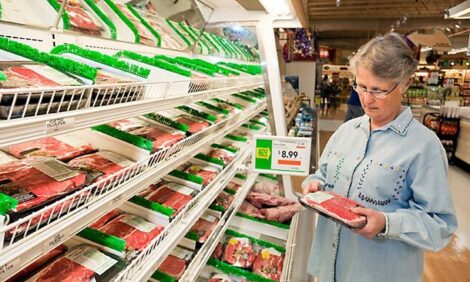



Market Preview: Pork Exports Have Ups & Downs
US - Weekly US Market Preview provided by Steve R. Meyer, Ph.D., Paragon Economics, Inc.US pork exports for May were, as expected, significantly lower than one year ago, with shipments to virtually all major US markets falling relative to last year. Total US pork exports were 231.2 million pounds, product weight. That is 34 per cent lower than last year, but remember, May of 2008 is the all-time record US export month at 350.4 million pounds, product weight.
Shipments grew on a year-on-year basis for only two major US markets: Australia (+22.1 per cent vs. 2008) and, surprisingly, Russia (+8.2 per cent from last May). The Russian figure is a surprise given the country’s ban on meat imports from several states in the wake of the H1N1 influenza virus outbreak. Those restrictions, however, always allowed shipments from some states with pork packing plants and Russian buyers apparently took advantage of those opportunities.
The largest year-on-year reduction was, as expected, in shipments to China. We shipped 95 per cent less pork to China this year than we did last year in May. A bit of a surprise was the drop in shipments to Hong Kong (down 71 per cent from last year) given that Hong Kong never officially stopped imports from the United States. Many observers, including me, had guessed that trade with Hong Kong had grown in order to satisfy buyers in China. But that was not the case – at least in May.
The other mild surprise was that exports to Mexico were down only 5.7 per cent from last year. But May 2008 was the first month of a recovery of shipments to Mexico and the year-on-year comparisons may get worse this summer unless business with Mexico picks up sharply. I have heard anecdotal reports of a rebound, but I don’t think “sharp increase” would be appropriate – yet.
Even shipments to Japan were lower, year-on-year, in May, falling by 15.7 per cent. The good thing, as always, is that Japanese buyers continue to buy high-value products. The value of May exports to Japan fell by “only” 6.4 per cent. Japan’s gate price mechanism, whereby the average value of a container of pork product must exceed the gate price to avoid a tariff, is a major driver of this high-value slant for Japan’s purchases.
Year-to-date, US exports are now 14 per cent lower than in 2008 (see Figure 1) and that number could worsen in the next three months as we compare this year’s performance to huge months last year.

Variety Meats Sales Encouraging
Year-to-date export value, a more important driver of hog demand than volume alone, is now 7.8 per cent lower than last year and a primary reason for soft hog demand and lower butcher hog prices.
Pork variety meat exports continue to be a bright spot with year-to-date quantities up 43.5 per cent and year-to-date value up 40.6 per cent. The primary driver of that growth has been Mexico where variety meat shipments thus far in 2008 are up 95 per cent in volume and 84 per cent in value. In fact, variety meat exports to Mexico in May were 68 per cent higher than last year and the value of those shipments was 49 per cent higher than last year.
This, plus the smaller-than-expected drop in muscle meats shipments to Mexico, tells me that the main driver of lower exports was the Mexican economy and, quite possibly, the impact that the H1N1 influenza virus outbreak had on the economy during May. Take most of a week out of any country’s economy and you very likely have a significant impact on consumers’ incomes and expenditures. This reduction in pork exports and increase in variety meat exports could well be simply a symptom of less money to spend.

Feed Costs Ease
Finally, last week’s World Agricultural Supply and Demand Estimates provided some more respite from high feed costs. USDA is now forecasting a 12.3 billion bushel corn crop and 1.55 billion bushels in storage at the end of the 2009-2010 crop year. It is also forecasting a 3.26 billion bushel soybean crop with 250 million in 2009-2010 year-end stocks – much higher than previously predicted levels for this fall.
Those estimates, plus the acreage estimates of June 30, have pushed new crop corn $0.60/bu. lower and new crop soybean meal $20/ton lower. The impacts on forecast feed prices (Figure 3) and breakeven hog production costs (Figure 4) have been dramatic. While losses of $2.13/cwt. for the next 12 months are no cause for celebration, they beat the early June estimates by a mile – and may be critical for some producers who are willing to lock in at least some of the profits being offered.












